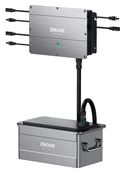Anyone who thinks that their files are no longer available after deleting them with the usual procedures is wrong.
Basically, they are just no longer visible and the space they occupied is released.

Of course there are tools, both for a fee and as freeware, that do this, but Windows also brings a tool that does just that: cipher
This tool has existed since Windows 2000 and is available in all subsequent operating systems such as Windows XP, Windows Vista or even Windows 7.
This small but useful command line tool, which is hardly noticed by a user, masters the so-called wiping, i.e. the secure deletion of files and folders by repeatedly overwriting this data.
cipher overwrites the unused memory area with ones, zeros and then again with random numbers, so the data in the "free areas" are very safely destroyed and can only be reconstructed by "professionals" with enormous technical effort.
Important:
Existing folders and data are not touched, only the free areas are overwritten!
So all data that you want to keep can remain on the drive, they remain untouched.
Nevertheless, when using such tools, it is always advisable to make a data backup on an external data carrier.
The use of cipher
First of all, all files and folders that should not fall into other hands should be deleted normally.
Also delete the contents of the trash and close all running programs, including those running in the background as far as possible, as these can restrict the use of cipher.
If necessary, the swap file should be deactivated for this process and the temporary files of the system and the browser should also be emptied, because the information contained therein is no concern of anyone.
Start the cipher
Start the command prompt with the Windows key + R
Then enter CMD and press Enter, this starts the command prompt.
Then the possible parameters of cipher can be checked with the command cipher.exe /? be called.
Whoever does this will be amazed to read a lot about encryption and little about deletion.
This is because cipher.exe is a utility for EFS (Encrypting File System), but with useful functions that go beyond that, such as. wiping, i.e. the secure deletion of files and folders.
So we're only interested in one command, namely cipher / WDrive
Whereby drive in this example stands as a placeholder for e.g. C: \ or D: \ or the specific drive letter.
So we need that Parameter W
/W
Removes data from available, unused space
on the volume. All other options are ignored if
this option is selected.
The specified directory can be in any
Location on the local volume. If it's a
Mount point or a reference to a directory
another volume, the data on that volume is removed.
In this example we apply cipher to a USB stick with the drive letter i: \
Enter the following command followed by Enter, cipher.exe starts immediately.
cipher / W: i: \
Cipher is thorough but also very slow, so depending on the capacity of the free space to be deleted on the drive, this can take a long time.
Cipher first overwrites the free area with zeros, then with ones and, in the third step, again with random numbers.
A progress indicator in the form of small dots shows the activity of the tool, so patience, security has its price and when it is time.
| Transparency: | This article may contain affiliate links. These lead directly to the provider. If a purchase is made through this, we receive a commission. There are no additional costs for you! These links help us to refinance the operation of win-tipps-tweaks.de. |
This tip comes from www.win-tipps-tweaks.de
© Copyright Michael Hille
Warning:
Using Registry Editor or its tips incorrectly can cause serious system problems that may require you to reinstall your operating system. Tampering with the registry files and using the tips is at your own risk.


